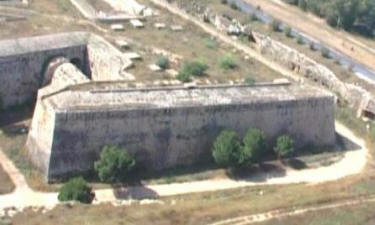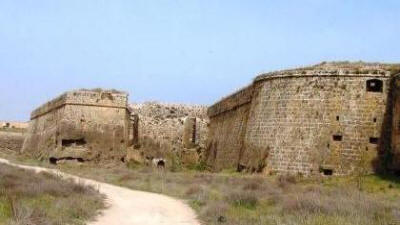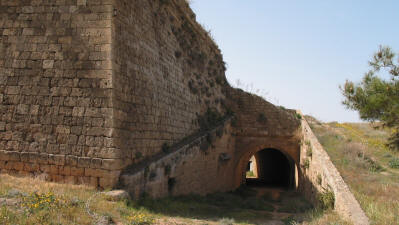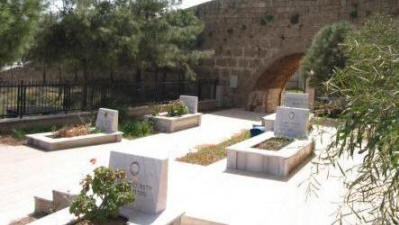Martinengo Bastion (Tophane),
Famagusta, North Cyprus
 |
| The Martinengo Bastion |
The Martinengo Bastion, originally called the Tophane, can be found in the north west corner of the walled city.
When the Venetians arrived in Cyprus, they very quickly realised that the walls of none of the cities were suitable for modern defence. They therefore set about a massive construction project to bring them all up to state of the art.
 |
| View of the Bastion From the Moat |
In Famagusta, they realised that the weakest part of the walls was in the north west corner, and in 1550, they brought over Giovanni San Michele, a renowned Venetian architect to redesign and strengthen this area. This he did over a nine year period.
The Martinengo bastion is one of the finest examples of military architecture, being shaped like a barbed arrow head pointing out to landward. The shape of the bastion meant that not only did it command a large field of fire away from the walls, but ensured that should any attackers manage to enter the moat area to attack the weaker walls, its field of fire could also be directed along the line of the walls.
 |
| Ramp Down to Bastion Interior |
Where possible, its lower sections were built into the bedrock, thus negating any possibility that attackers could Tunnel under it to lay mines.
On the city side of the wall, the Martinengo bastion has a series of ramps, designed to be wide enough for horses and carts to carry munitions to the interior of the bastion. Inside the bastion are chimneys for ventilation, and storage areas for gunpowder barrels and cannon balls, as well as for the defenders themselves. As the bastion is massive, over a square mile in size, there is also a curved passageway to allow movement from one side of the bastion to the other.
 |
| Graves on the Martinengo Bastion |
It is known that Leonardo da Vinci (1452-1519), although a pacifist, made a study of the theory of fortification. And Michelangelo (1475-1564) built the fortifications of Florence in 1528. The Martinengo Bastion shares many similarities to to what remains of the records of those, and it is thought that this is where Giovani San Michele drew his inspiration.
During the Ottoman siege of Famagusta, a venetian force under the command of Hiernino Martinengo was sent to assist the besieged city. Commander Martinengo died en route, and his body taken to Famagusta. As he was very popular with his troops, the bastion was named after him.
On the bastion, you will also find a small, well kept, cemetery containing the graves of five people killed during the troubles of the mid 1960s.
The area round the Martinengo Bastion is marked on some maps as being inside a restricted military area. This is not correct, and has not been for some time, although the barbed wire and "no photography" signs are still in place.
See the location on Google maps.
Back to Famagusta index.